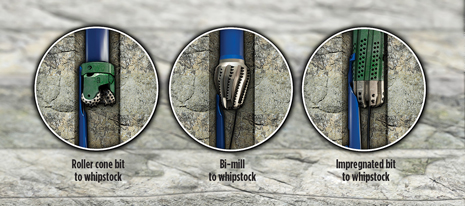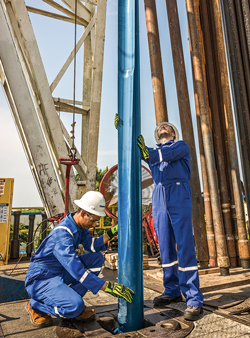JIMMY LAND, Schlumberger
 |
| The expandable anchor of the openhole whipstock and sidetracking system avoids damaged anchor packers through an all-metallic external design. The anchor design allows flexibility across a range of hole sizes for a given tool size. |
|
Openhole sidetracking is most commonly applied in three scenarios: to drill a horizontal lateral from a main wellbore; to drill a lateral in a multilateral well; or to manage unplanned events, such as a collapsed borehole or lost BHA. Traditionally, the most frequently employed openhole sidetracking methodology began with setting a cement plug, followed by a directional BHA, once the cement had hardened. The success of the plug-setting operation depends on the formation’s compressive strength, the quality of the cement, and the cure time. Consequently, a plug failure will result in added trip time, the need for a new cement plug, re-drilling previously drilled footage, and the loss of rig time and reconfiguration of drilling trajectory.
Furthermore, the traditional approach is a costly, time-consuming process, in which the cement must be first mobilized and allowed to set, followed by tripping back into the hole with a drill bit to dress off the plug to the kickoff point, and then time-drilling at inches per hour, to slowly begin departure from the original borehole. The cementing process can take up to a full day prior to the actual start of the sidetracking process. In the event that the cement does not have enough compressive strength, the cement would have to be drilled out and reset, essentially restarting the sidetracking process from scratch.
In addition to being costly and time-consuming, traditional sidetracking operations are often considered unreliable, especially when dealing with highly deviated wellbores, smaller-diameter openhole sections, deep openhole sections and high-pressure intervals. When working in environments such as deep water—with elevated temperatures and pressures—cement plugs rarely exhibit strength greater than the formation, making it difficult to use as a kickoff point. In highly deviated wells, cement plugs can get strung out along the wellbore. In many instances, numerous cement plugs have to set before acceptable results can be obtained, which can make the process lengthier and more expensive.
An innovative technical solution has been needed to reduce the uncertainties associated with the conventional cement plug approach, thus improving the consistency and reliability of sidetracking operations. As the industry continues to move into more challenging environments—such as deepwater exploration wells with highly deviated boreholes, or unconventional reservoirs characterized by hard and/or abrasive rock formations—the need to improve sidetracking reliability has increased greatly. Schlumberger initiated an effort to identify new tools and procedures that can be utilized to increase the operational reliability in openhole sidetracking operations.
A NEW DIRECTION
A comprehensive technical solution was developed by Schlumberger, and successfully pioneered by Chesapeake Operating Company, while working in the Granite Wash formation. The TrackMaster OH openhole whipstock and sidetracking system was developed to consistently, and reliably, achieve a precise kickoff, with a single trip, Fig. 1. The openhole sidetracking system consists of seven components:
- A hydraulically activated expandable anchor that establishes a firm, three-point grip on the borehole wall, locking the tool system both vertically and azimuthally
- A bit-friendly steel ramp, typical of a conventional whipstock
- A diamond-impregnated bit attached at the top of the ramp with a shear bolt
- A turbodrill with a multi-stage power section and directional bearing package (temporarily locked until the anchor was set)
- A running tool containing hydraulic oil for setting the anchor
- A multi-cycle bypass valve that allows measurement-while-drilling (MWD) mud pulse signals to pass critical data to the directional driller, to ensure correct whipstock orientation (after signals pass, the valve closes to allow the anchor to be set).
 |
| Fig. 1. The openhole whipstock and sidetracking system is secured at the kickoff point by an all-metallic expandable anchor. |
|
The Granite Wash formation is particularly challenging to drill. Centered in western Oklahoma, and extending under the Texas Panhandle area, Granite Wash is characterized by erratic transitions from hard, abrasive strata to soft formations, resulting in unpredictable performance by the steerable drilling assembles. Conditions vary from one well to the next, so there is no way to predict drilling difficulties in advance. This has resulted in costly sidetrack attempts, missed landings and multiple bit trips.
One of the challenges associated with the formation was to reduce the number of trips. The conventional sidetracking technique has typically been used—run and set a whipstock/anchor assembly at the kickoff point in a separate trip, using a different BHA. Once the whipstock is secured in place, the directional drilling assembly was run to initiate and finish the curve, and to reach the landing point. However, to improve economics, the extra trip needed to be eliminated.
 |
| Fig. 2. A TrackMaster OH system, configured with a diamond-impregnated bit and turbodrill, provided a one-trip sidetrack in the Oklahoma Granite Wash formation. |
|
In May 2012, a field trial was conducted with the objective of drilling a lateral from a vertical pilot hole, to tap the production zone of the Granite Wash formation. The openhole sidetracking and whipstock system (Fig. 2) was run in the hole, and the deflector was hydraulically set with a kickoff point at 12,520 ft. After drilling for 605 ft, the drilling assembly was pulled out of the hole, due to a decrease in ROP. A field examination revealed that the impregnated bit was rung out and had shoulder damage. A survey was taken using an MWD tool, and the recorded survey points were plotted using in-house software.
The landing point was reached with the next drilling assembly, which consisted of a turbine and long-gauge impregnated bit. Despite abrasive transition drilling conditions, no problems were encountered while pulling the first drilling assembly out of the hole, or when tripping with the next lateral drilling assembly back to the bottom of the hole. The fact that tripping operations took place, undeterred, indicated that the curve was smooth, and did not have any undesirable ledges. No borehole reaming was required.
FIELD TRIALS: SUCCESS ON LAND AND SEA
The openhole sidetracking and whipstock system has been run in more than 1,200 field trials. Field applications have included unconventional plays throughout the U.S., and multiple offshore locations, globally.
Eagle Ford shale. In South Texas’ Eagle Ford shale, a multi-well comparison test was run in an attempt to quantify the benefits of the new system, compared to the cement plug technique described earlier. The development technique employed by the operator involved drilling and logging pilot holes to the top of the Edwards formation, then plugging back to the top of the Eagle Ford and kicking-off the laterals.
The top four performing wells drilled, using the cement plug technique, were compared to the top eight wells drilled using the new whipstock technique. On average, wells using cement plugs required 8.3 days to land the curve, compared to wells using the new whipstock, which required an average of 6.8 days to land the curve. The fastest well for cement plugs was landed in 7.2 days, whereas the fastest whipstock well was landed in 5.0 days.
On the downside, the worst performance for cement plug wells was 19.7 days, compared to the worst whipstock well performance of 17.4 days. Additional advantages of the whipstock technique, over the traditional cement plug technique, included the 100% isolation of the pilot hole, in addition to providing a solid bottom for sidetracking operations. Furthermore, the whipstock technique provided the most assurance of sidetracking success on the first attempt.
Gulf of Mexico. The openhole whipstock and sidetracking system was used in an openhole deepwater application in the GOM. Drilling in Keathley Canyon, in more than 6,000 ft of water, the 20-year-old deepwater field—consisting of oil, gas and condensate—is characterized by multiple layers and complex faults. When the operator attempted, unsuccessfully, to kick off multiple times from a cement plug, a sidetracking alternative was required to perform the 8½-in. openhole sidetrack, in the 34° original hole, at more than 31,500 ft. The sidetracking alternative would enable directional drilling assemblies to drill ahead to the planned target, where the whipstock was initially set.
The TrackMaster OH system was selected to provide an endpoint for the existing wellbore, and a stable platform to initiate the wellbore departure. An openhole whipstock and sidetracking system was deployed, and set with a hydraulic anchor at 31, 534 ft, in one run. Using a hydraulically expandable reamer, the anchoring location had been enlarged while drilling, then cemented and re-drilled, as part of the earlier cement plug sidetracking attempt.
To predict the departure path, whipstock simulation software and engineered drilling system design software were used. This ensured that the drilling assembly could drill past the whipstock, to build the required separation from the original borehole. An angle-building drilling assembly was used to drill across the whipstock and establish the rathole. Finally, a rotary steerable system BHA was tripped past the whipstock and drilled to TD.
In the end, the openhole whipstock and sidetracking system provided a clean 8½-in. sidetrack on the first attempt, which enabled subsequent directional drilling assemblies to regain the lost hole by drilling ahead to the planned target, according to the revised directional drilling plan. The operation set a new world record for the deepest openhole whipstock sidetrack, set at 31,513 ft.
Thailand. In Khon Kaen, offshore Thailand, an operator, engaged in a slot recovery operation, needed an openhole sidetrack to access new reserves. However, it was determined that departing the original wellbore in a conglomerate formation, with an unconfirmed compressive strength of 25,000 psi, could possibly present a problem for a standard openhole cement plug sidetrack. A TrackMaster OH whipstock, with a 133/8-in. by 20-in. expandable anchor, and a 17½-in. bi-mill, as shown in Fig. 3, was selected for the operation. The openhole sidetracking and whipstock system, which uses a patented multi-ramp design to deliver a high-quality kickoff point and minimize the dogleg across the whipstock face, thus allowing a more consistent well path, provided the operator with the ability to kick off.
 |
| Fig. 3. The openhole whipstock and sidetracking system can be configured as a single-trip sidetrack and drill-ahead system with a PDC, roller cone or diamond impregnated drill bit, along with directional steering through positive displacement motors, turbodrills or rotary steerable systems. |
|
The kickoff from the original borehole and the 5-m pilot hole were completed in one run, with the complete sidetracking operation finishing in 6 hr. Once the sidetracking operation was complete, and after tripping out of the hole with the milling assembly, the operator was able to continue drilling the well and develop new reserves. To date, the 17½-in. sidetrack is the largest openhole whipstock sidetrack operation, globally.
CONCLUSION
 |
| Fig. 4. An engineer prepares a TrackMaster OH system prior to running in the hole. |
|
The TrackMaster OH openhole sidetracking and whipstock system enables a new direction, to address the challenges associated with openhole sidetracking operations, Fig. 4. The system removes the uncertainties most often associated with openhole sidetracking operations using a cement plug, while also increasing the operation’s reliability. Field performance has validated the functionality and dependability of the tools and procedures. Furthermore, the system has also reinforced cost savings and operational safety over the traditional cement plug approach. 
|
The author
JIMMY LAND is the wellbore departure global business manager for the Drilling Tools & Remedial segment at Schlumberger. |
|







